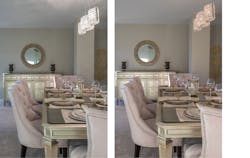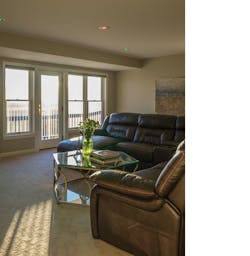Tunable lighting and programmatic controls can deliver a natural-light experience in a residential setting that enhances human wellbeing. In Part 2 of a series, MAURY WRIGHT describes the experience of the homeowner in a major lighting for health and wellbeing project.
In our prior issue of LEDs Magazine, we discussed the concept of lighting for health and wellbeing, or human-centric lighting, and examined a specific solid-state lighting (SSL) system designed for such applications. We know such technology holds great promise to positively impact people, although as we discussed the science behind the concept is still developing. Still, we know that differing spectral power distribution (SPD) and CCT can both please or disrupt the human visual system and impact physiology through non-visual receptors. Having discussed how SSL manufacturer Ketra is approaching such human-centric lighting deployments, here we will describe the experience of a homeowner that went through the installation and commissioning process of such a system and now lives with the lighting installation every day. We’ll discuss examples chronologically and reveal the ultimate impact on the homeowner in this second part of an article series.
FIG. 1. Near the entryway of the home on a fall afternoon, the Natural setting produces a neutral CCT (left). A switch to the Relax setting in the entryway results in a much warmer CCT (right).
Even as this project unfolded, the issue of lighting for health remained hotly debated. At the Light+Building (L+B) event in Frankfurt, Germany, Seoul Semiconductor held a mini symposium on the topic. Well-known researchers in the space expressed vastly different opinions on the topic. As our colleagues atLuxwrote, noted Oxford University professor Russell Foster said researchers have yet to establish a light recipe for human-centric lighting at this point. But Foster did not suggest the industry stop testing the known concepts, and he also said higher light levels than those typically found in general lighting may be required. Another speaker, Dr. Octavio Perez of Mount Sinai Hospital in New York, was far more bullish on the technology near-term as we covered in our L+B report.
We will of course continue the discussion at our Lighting for Health and Wellbeing Conference this summer.That program should be available by the time you read this. Meanwhile, let’s consider the home project to which we had firsthand insight.
Ketra controls
You may want to review Part 1 of this series to fully understand the following section of the article, and here we will offer a brief refresher. The Ketra system supports four scenes in each area of an SSL project — in a home, it’s typically different scene settings in each room. The company has developed what it considers ideal settings tied to specific activities commonly performed in a given space and based on the work of the Lighting Research Center (LRC) and the Circadian Stimulus (CS) metric. The system automatically changes characteristics such as SPD, CCT, and light level based on time of day, day of year, and the scene or activity selected at the room control panel. Moreover, occupants can further finetune the settings based on their preferences.
The best way to illustrate the operational capabilities of the Ketra system is through examples. Consider the Fig. 1 images that were taken near the entryway of the home and adjacent to the formal dining area. Both images were captured at around 5:00 PM in late fall. On the left side of Fig. 1, the scene was set to Natural and the system was still producing a neutral CCT in late afternoon and relatively high intensity. At right, the scene had been changed to Relax and, as you can see, the CCT is much warmer and the intensity is lower.
FIG. 2. At around noon in a living area, the Relax setting delivers relatively low-intensity light (left). A switch to the Natural setting in the living area raises intensity to more closely mimic natural light at noon (center). The Away setting is used to extinguish lights when no one is present in a space (right).
Now let’s consider some environments captured around noon in one of the living areas of the home. The images in Fig. 2 depict the Relax, Natural, and Away scenes that are programmed for the living area. In the noon timeframe, natural light is cool to neutral in terms of SPD, and that element is evident in the first two images. But the Relax setting results in lower intensity relative to the Natural setting in the second image. And the Away setting in the third image results in the lighting being turned off.
Presets and preferences
Clearly, the actual operation of a Ketra system will depend on the combination of the research by Ketra that’s delivered in preset scenes and on the preferences of the occupants of the space. Consider a breakfast area off the kitchen of the home we are discussing here. Fig. 3 shows the breakfast table with the control set to Dining (left). The CCT is shifted to cool, both matching the environment for a morning meal and providing very good visual acuity for reading. For a contrast, consider the Natural setting that was captured around 7:00 PM at night with much warmer CCT (right).
Now let’s consider an example of how the chronologically programmable features come into play. For any given setting such as Natural, the Ketra system dynamically varies the lighting throughout the day as mentioned earlier. The Fig. 4 images were both taken in the formal dining area of the home, with the left taken at night and the right in the morning. In both cases, the Ketra controls were set to Natural. The CCT in the morning was relatively cooler while at night the environment had warmed considerably.
The dining area also affords an opportunity to discuss how the Ketra system accommodates legacy fixtures or lamps in a space. Ketra offers a full line of programmable lamps in various form factors. And the company offers downlights and a variety of linear luminaires. But there will invariably be the need in a home to accommodate legacy fixtures.
Consider the chandelier in the formal dining area. That suspended luminaire utilizes incandescent lamps. In some cases, a homeowner might have a chandelier that could utilize a Ketra lamp, but that certainly won’t always be the case. Still, the Ketra system can control legacy lighting using phase-controlled dimming. The system would obviously not be able to control CCT. But in an area such as the dining space, the incandescent lamps installed would inherently dim to a warmer CCT based on the phase control. You can see the legacy control in action when comparing the images in Fig. 5. The Natural scene on the left is cooler and brighter, whereas the Relax scene on the right features a warmer CCT — and that chandelier has also warmed considerably as you can see.
Entertainment scenes
As mentioned previously, Ketra’s stated mission is delivering natural light under which people feel well and flourish. Still, we must also mention that the system can deliver some sizzle as well. The company does not promote the SSL products or system as dynamic and capable of color-changing. But the LED light engine in the Ketra products can produce any color. And the typical homeowner would probably want some of that capability in an installation.
The homeowner in this case enjoys entertaining, and many of the spaces in the home have Entertain settings on the control panels. Moreover, the environment can be further customized by direct input on the control panels or smart devices.
Look at Fig. 6 and you can see the downlights set to different colors, although with the sunlight present the colors aren’t quite as apparent in the space. Now look at Fig. 7 and you can better see the capabilities of the system to deliver vibrant color scenes, perhaps for a special party.
Commissioning the system
So having revealed how the lighting system operates, let’s discuss how it is installed and commissioned. As we mentioned in Part 1 of this article, the Ketra technology is proprietary. It primarily uses a wireless communication scheme and one or more hubs or gateways that link wireless-enabled luminaires with control panels and other smart lighting elements.
FIG 4. In the main dining area at night, the Natural setting yields warm tones (left). The Natural setting in the morning results in a much cooler CCT in the main dining area (right).
At this point in time, the Ketra system is not one that a typical homeowner would undertake installing on a do-it-yourself basis. Typically, Ketra employees or the company’s trained distributors or manufacturer’s representatives would manage the installation process, including the commissioning.
Ketra ships the system pre-commissioned for what its research and work with the LRC has determined is the most likely natural light experience for the general population. In the case of the project that we are covering here, the homeowner is overly sensitive to light, as we mentioned in Part 1. In such instances, a Ketra employee or representative can modify the programming of the system or, as we described it in Part 1, the curated content produced by the smart platform. In the case of the home retrofit here, light levels were in general reduced relative to the baseline settings that Ketra uses.
FIG. 5. The Ketra HCL platform supports legacy lamps for fixtures such as this chandelier (left). Legacy phase-dimming controls result in a dim-to-warm experience in the Relax mode (right).
The homeowner did find the installation and commissioning process somewhat inconvenient. Ketra representatives spent parts of a number of days and nights on the scene installing the system and optimizing the settings. And changes are still being made months into the project. Not all require an in-home visit; some can be accomplished remotely. But one drawback of the system is surely the inability of the homeowner to easily change the programming.
Compatibility and limitations
The homeowner has also found frustration with the bounds of the SSL system. In a typical Ketra scenario, the entire home becomes part of the Ketra universe — every light source, including legacy lamps, is controlled by the system.
So consider the homeowner’s bedroom. There are beautiful LED lamps and fixtures in the space and there is a legacy bedside lamp that might be used for reading prior to sleep. The control system in that space has four scenes. To simply turn all the lights off while leaving the table lamp powered on, you essentially have to dedicate one of the four preset scenes to that desired environment. The homeowner in this case would almost prefer manual control of that one lamp; of course, that’s a possible outcome.
The homeowner has also found it limiting that the Ketra system doesn’t yet work with voice-controlled home-automation products such as Amazon Alexa. Much lower-cost tunable lighting products do work with such devices, although as we will discuss in a moment, they don’t produce the same lighting experience.
FIG. 6. The Ketra system can deliver saturated colors in addition to natural white light.
Ketra has said that it is working on new user interfaces and expects to have support for products like Alexa or Apple HomeKit and Siri. And realize that Ketra’s initial target for its platform was commercial spaces. In newer commercial areas, the lighting is always comprehensively controlled and products such as Alexa are not in use. But as the cost of tunable lighting drops, we will surely see much more demand for human-centric lighting in residential settings.
[Editor's update: After the lighting system covered in this article was installed and the data for this article gathered, Ketra has in fact brought compatibility with Amazon Alexa to market: https://www.ketra.com/products/integration/alexa.]
Natural lighting experience
While the control and commissioning experiences have been challenging, the homeowner absolutely loves the overall lighting experience. Sleep cycles have been improved. The light in spaces such as the kitchen provide far better illumination on task surfaces such as counters. The lighting enhances activities such as TV viewing. And the Entertain settings can be the life of the party.
Still, it’s the overall comfort in the space that has most surprised the homeowner. It’s something that is almost impossible to quantify. But after living under the human-centric lighting installation for months, the homeowner finds that lighting in other places — homes of friends and family, public hospitality settings, workplaces, and more — is noticeably uncomfortable. Returning to that home and that natural light experience provides a welcome respite.
FIG. 7. An Entertain mode can be used to make lighting the life of the party.
Indeed, we mentioned up front in this article that debate remains as to what light recipes might guarantee better sleep or increased productivity. No one has the exact answer. But projects such as this home retrofit make it clear that the SSL industry can pursue human-centric lighting installations while doing no harm to those exposed to the light. And, in fact, the people exposed to such lighting will likely have a positive experience.
The LED and SSL industries have unfortunately focused almost exclusively on energy efficiency to this point, especially in commercial settings. The first goal has been to cut electrical costs. And that is a worthy goal, although quality of light should always matter.
We’d hope that as the lighting industry moves from the energy-focused phase that some have called LEDification to the next phase of looking for other value and benefits that can be derived from LED sources, human-centric lighting is one of the concepts that will shine. Companies such as Ketra are fully focused on the mission and have demonstrated that they can still deliver energy efficiency along with the natural light experience.
*Updated June 13, 2018 11:50 AM for Amazon Echo/Alexa information.










